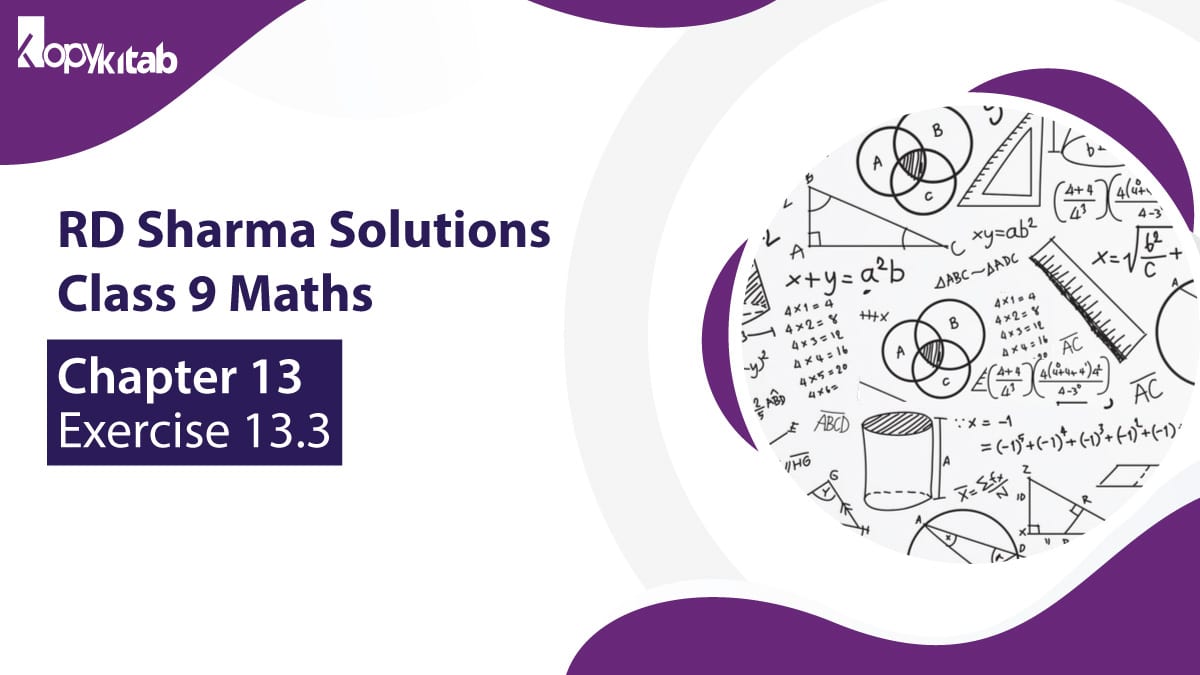RD Sharma Chapter 13 Class 9 Maths Exercise 13.3 Solutions is about the Graphing of Linear Equations, which includes the topics like- Every point on a line will be a solution to an equation, Every solution of an equation will be a point on the line. In this exercise, learners have to deal with the graph of linear equations in two variables. We need to find the linear equation in the form ax + by + c = 0. Express ‘y’ in terms of ‘x.’ Provided any values of ‘x’ and determine the similar values of ‘y’. Plot the spots on the graph and sketch a line passing through points marked. The line so concerned is the graph of the provided equation.
Students start practicing with the RD Sharma Chapter 13 Class 9 Maths Exercise 13.3 Solutions PDF attached with the article to score well in the exam. The questions of the PDF are prepared by our experts with the help of the Previous Year’s Question Paper, CBSE Text Book, and RD Sharma of Class 9.
Learn about RD Sharma Chapter 13 (Linear Equations In Two Variables) Class 9
Download RD Sharma Chapter 13 Class 9 Maths Exercise 13.3 Solutions PDF
Solutions for Class 9 Maths Chapter 13 Linear Equations in Two Variables Exercise 13.3
Important Definitions RD Sharma Chapter 13 Class 9 Maths Exercise 13.3 Solutions
Graphing of Linear Equations keypoints
It can be resolved that, for a linear equation in two variables-
Every point on a line will be a solution to the equation.
Every solution of an equation will be a point on the line.
Therefore, every linear equation in two variables must be interpreted geometrically as a straight line in a correspondent plane. Points on a line are the solution of an equation. That’s why the equations with degree one are known as a linear equation. This representation of the linear equation is called as graphing of the linear equations in two variables.
Considering a solution of linear equation in two variables is the pair of numbers (x and y), we can draw the solutions in a coordinate plane.
Suppose the equation-
2x + y = 6 —(1)
Some solutions of the equation are, (0,6), (3,0), (1,4), (2,2) because, they satisfy (1).
We can describe the solution of (1) using a table as displayed below-
|
x |
0 |
3 |
1 |
2 |
… |
|
y |
6 |
0 |
4 |
2 |
… |
Plot the above points (0, 6), (3, 0), (1, 4), (2, 2) in the coordinate plane.
Take any two points and connect those to form a line. So, the line is PQ. It is noticed that all four points are lying on the corresponding line PQ.
 Suppose any other point on the line PQ, for example, take point (4,-2), which lies on PQ.
Suppose any other point on the line PQ, for example, take point (4,-2), which lies on PQ.
Let us check whether this point completes the equation or not.
= Replacing (4,-2) in (1) gives,
= LHS = (2×4) -2 = 6= RHS
= Therefore, (4,-2) is the solution of (1).
= So, if we get any point on the line PQ, it will satisfy (1).
= It can be noted that,
= All the points say, (p, q) on a line PQ provides a solution of 2x + y = 6.
= All the solutions of 2x + y = 6 lie on the line PQ.
= Points that are not the solution of 2x+y = 6 will not lie on the line PQ.
Example of RD Sharma Chapter 13 Class 9 Maths Exercise 13.3 Solutions
Ques- A number is 27 more than a number get by reversing its digits. If its unit’s and ten’s digits are x and y, respectively, write the linear equation representing the statement.
Solution-
The original number is 27 more than a number taken by converting its digits.
= The given number is in the form of 10y + x.
= The number given by converting the digits of the number is 10x + y.
Based on the statement-
= 10y + x = 10x + y + 27
= 10y – y + x – 10x = 27
= 9y – 9x = 27
= 9 (y – x) = 27
= y – x = 3
= x – y + 3 = 0
The above equation represents the needed linear equation.
